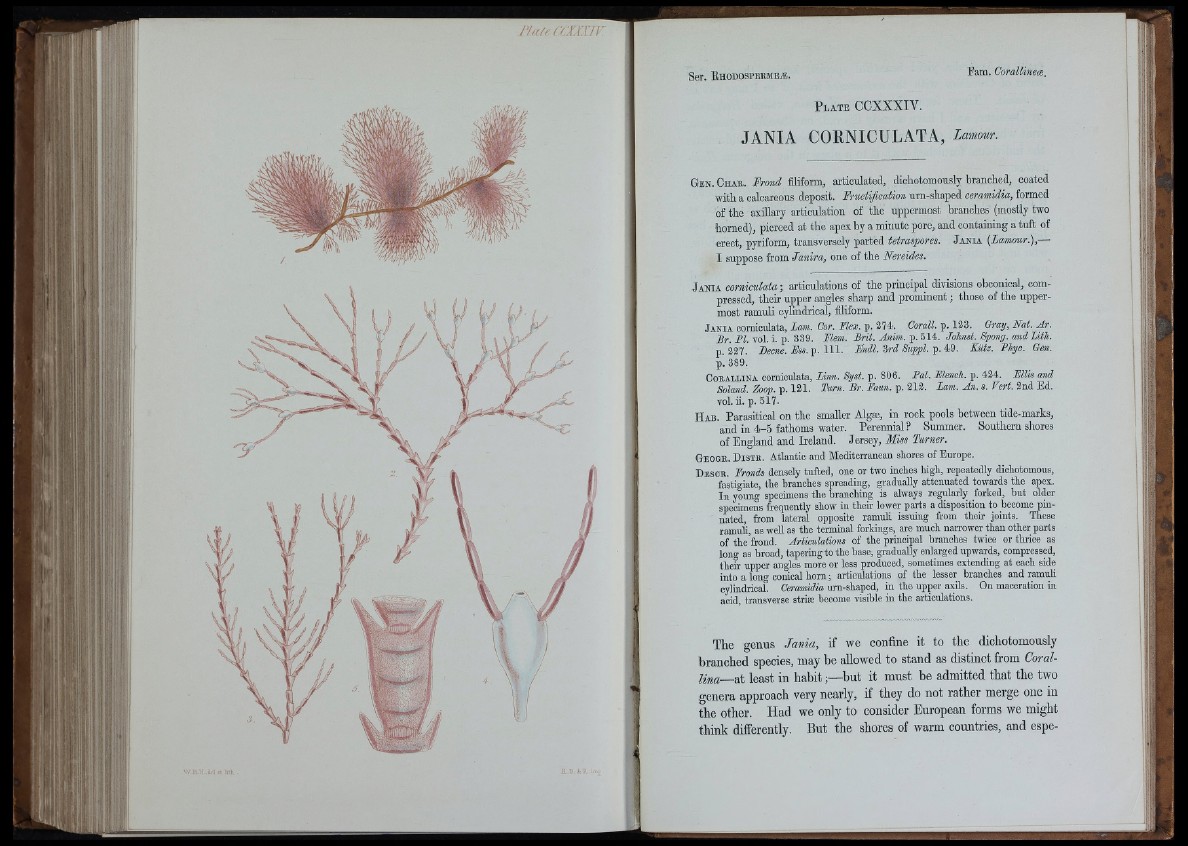
p / a r i c a x . m ' .
WIl.n.dH ri '-.-.k
P l a t e CCXXXIV.
JANIA CORNICULATA, Lamour.
G bn . Ch a r. Frond filiform, a rtic u la ted , d ichotomously b ra n ch ed , coated
w ith a calcareous deposit. Fructification u rn -sh a p e d ceramidia, formed
of th e axillary a rtic u la tio n of th e u p p e rm o s t b ran ch es (mostly two
h o rn e d ), pie rc ed a t th e apex by a m in u te p ore , a n d c o n ta in in g a tu f t of
ere ct, pyriform, tran sv erse ly p a rte d tetraspores. J a n ia {Lamour.),—
I suppose from Janira, one of the Nereides.
J a n ia cornimlata; a rticu la tio n s of th e p rin c ip a l divisions obconical, comp
ressed, th e ir u p p e r an g le s sh arp a n d p rom in e n t; th o s e of th e u p p e rm
o s t ram u li cylindrical, filiform.
J a n ia corniculata, Lam. Cor. Wex. p. 274. Corail. p. 123. Cray, Nat. Ar.
Br. PI. vol. i. p. 339. I lm . Brit. Anim. p. 514. Johnst. Spong. andLith.
p. 227.' Beene. B ss.-p .lW . Fndl. 3rd Suppl.-ÿ. 49. Kütz. Phyc. Gen.
p . 389.
Corallina corniculata, lAnn. Syst. p. 806. Pal. Flench, p. 424. Fllis and
Soland. Zoop. p. 121. Turn. Br. Faun. p. 212. Lam. An. s. Vert. 2nd Ed.
vol. ii. p. 517.
H ab. Parasitical on the smaller Algæ, in rock pools between tide-marks,
and in 4-5 fathoms water. Perennial ? Summer. Southern shores
of England and Ireland. Jersey, Miss Turner.
Geogr. Distb. Atlantic and Mediterranean shores of Europe.
Desce. Fronds densely tufted, one or two inches high, repeatedly dichotomous,
fastigiate, the branches spreading, gradually attenuated towards the apex.
In young specimens the branching is always regularly forked, but older
specimens frequently show in their lower parts a disposition to become pinnated,
from lateral opposite ramuli issuing from then joints. These
ramuh, as weU as the terminal forkings, are much narrower than other parts
of the frond. Articulations of the principal branches twice or thrice as
long as broad, tapering to the base, gradually enlarged upwai'ds, compressed,
their upper angles more or less produced, sometimes extending at each side
into alo n g conical horn; articulations of the lesser branches and ramuli
cylindrical. Ceramidia urn-shaped, in the upper axils. On maceration in
acid, transverse striæ become visible in the articulations.
The genus Jania, if we confine it to the dichotomously
branched species, may be allowed to stand as distinct from Coral-
«—at least in habit;—but it must be admitted that the two
genera approach very nearly, if they do not rather merge one in
the other. Had we only to consider European forms we might
think differently. But the shores of warm countries, and espe